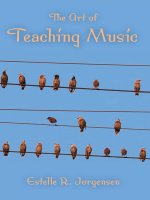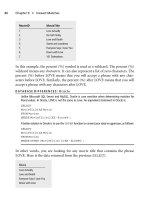212. Scott Joplin_ The King of Ragtime Music ppsx
Bạn đang xem bản rút gọn của tài liệu. Xem và tải ngay bản đầy đủ của tài liệu tại đây (80.27 KB, 3 trang )
Scott Joplin: The King of Ragtime Music
Written by Caty Weaver
28 May 2006
(MUSIC)
VOICE ONE:
I’m Steve Ember.
VOICE TWO:
And I’m Barbara Klein with People in America in VOA Special English. Today we tell about the life
and work of one of America’s greatest music writers: Scott Joplin, the King of Ragtime.
(MUSIC)
VOICE ONE:
That song is called “Maple Leaf Rag.” Scott Joplin wrote it more than one hundred years ago. The
song changed Joplin’s life. It was very popular. The composer earned a good living from the sales of
the sheet music. He also became famous.
But, even today, much about Scott Joplin remains a mystery. There is
conflicting information about the most basic facts, like when and where he
was born.Official population documents suggest Scott Joplin was born in
eighteen sixty-seven and eighteen sixty-eight. He was born in Texas,
probably near the border with Arkansas. The Joplins moved to Texarkana,
Texas sometime after eighteen seventy-five and Scott grew up there.
(MUSIC)
VOICE TWO:
Scott was the second of seven children born to Giles and Florence Joplin. His father was a freed slave
who worked on the railroad. His mother cleaned people’s homes.
The whole Joplin family was musical. Scott’s father played the violin. His mother played the banjo.
And all the Joplins enjoyed singing together at home.
Scott learned to play several musical instruments. But Florence Joplin wanted her son to learn how to
play the piano. When Scott was about seven years old he began taking piano lessons with a music
teacher at his school. The Joplins were poor, so Scott’s mother paid for the weekly lessons with food.
Florence Joplin also got permission for her son to use a piano in one of the houses she cleaned in
Texarkana.
Florence and Giles Joplin separated before Scott became a teenager. Some experts think Scott blamed
himself for the break-up. Many experts also think Scott Joplin’s opera “Treemonisha” included
incidents of his life with his mother after Giles Joplin left. For example, the character “Treemonisha”
receives music lessons paid for by her mother who cleans people’s houses. Listen to this aria from the
opera. Carmen Balthrop is Treemonisha.
(MUSIC)
VOICE ONE:
Scott Joplin’s early piano lessons did not include ragtime. That kind of music was played in dance and
drinking places and was not considered acceptable.Scott first studied classical music with several
teachers. They included a German immigrant named Julius Weiss who probably had the strongest
influence on the boy.
VOICE TWO:
Scott left Texas when he was a teenager. He worked as a piano player and gave lessons in the guitar
and mandolin. In his twenties he settled in Sedalia, Missouri. He formed a group called the Texas
Medley Quartet. The group sometimes traveled great distances to perform. Scott Joplin began his
music-writing career in Sedalia. He attended college classes to learn to become a composer.
Joplin also got a permanent job in Sedalia playing the piano in a new nightclub. Sedalia’s most
important citizens visited the Maple Leaf Club. The job permitted Joplin time to write and play his
own work.
Something even more important happened to Joplin in Sedalia. He met John Stark, the owner of a
local music store. In eighty ninety-nine, Stark published the song “Maple Leaf Rag.” It was not
Joplin’s first published music. But it was the he was most proud of.
Stark offered to pay Joplin a percentage of each sale of “Maple Leaf Rag” sheet music. This was an
extremely unusual business agreement for a white publisher and black composer at that time. Usually,
white publishers paid only a small amount of money for full ownership of music written by African-
Americans. The agreement was very good for both Scott Joplin and John Stark.
(MUSIC)
VOICE ONE:
Ragtime music is dance music. It combines a solid, often lively, beat with a looser, complex melody.
Most experts agree that the traditional music and dance of American slaves played a big part in the
development of ragtime.
Here is a perfect example. Scott Joplin and John Stark published “A Breeze From Alabama” in
nineteen-oh-two. It is music for a dance called the two-step.
(MUSIC)
VOICE TWO:
John Stark decided that Scott Joplin was going to become too popular to stay in the small town of
Sedalia. He decided to move his music business to the big city of Saint Louis, Missouri. Joplin
moved to Saint Louis with a woman named Belle Hayden. Later they were married. But Joplin was
not as successful in love as he was in music. He and Belle separated in nineteen-oh-two.
Two years later Joplin married again. But his wife, Freddie Alexander, died just three months later.
The Scott Joplin Organization in Sedalia, Missouri says Joplin wrote this rag, “The Chrysanthemum,”
for his second wife.
(MUSIC)
After his wife’s death, in nineteen-oh-five, Joplin wrote a concert waltz called “Bethena.” The piece
has a sad sound to it, quite unlike Joplin’s earlier work. You might recognize it as the theme music for
the Special English program Words and Their Stories.
(MUSIC)
VOICE ONE:
Joplin lived in many places in the years that followed. He also worked on his opera, “Treemonisha.”
He had hoped his longtime business partner John Stark would publish it, but he refused. Stark did not
think a ragtime opera would sell.
After nineteen-oh-seven Joplin lived mostly in New York City. He and his new wife Lottie tried for
many years to get “Treemonisha” produced. But its opening night did not come until more than fifty
years after Joplin’s death.
By about nineteen fifteen, Scott Joplin began suffering badly from syphilis. The disease robbed him
of his ability to play piano. It also destroyed his ability to write music. He died in New York City in
nineteen-seventeen.
Scott Joplin left the world sixty musical works. These include many piano rags that are still played
today.
(MUSIC)
VOICE TWO:
This program was written and produced by Caty Weaver. I’m Barbara Klein.
VOICE ONE:
And I’m Steve Ember. Join us again next week for People in America in VOA Special English. We
leave you now with one of Scott Joplin’s prettiest rags, “Heliotrope Bouquet.”









